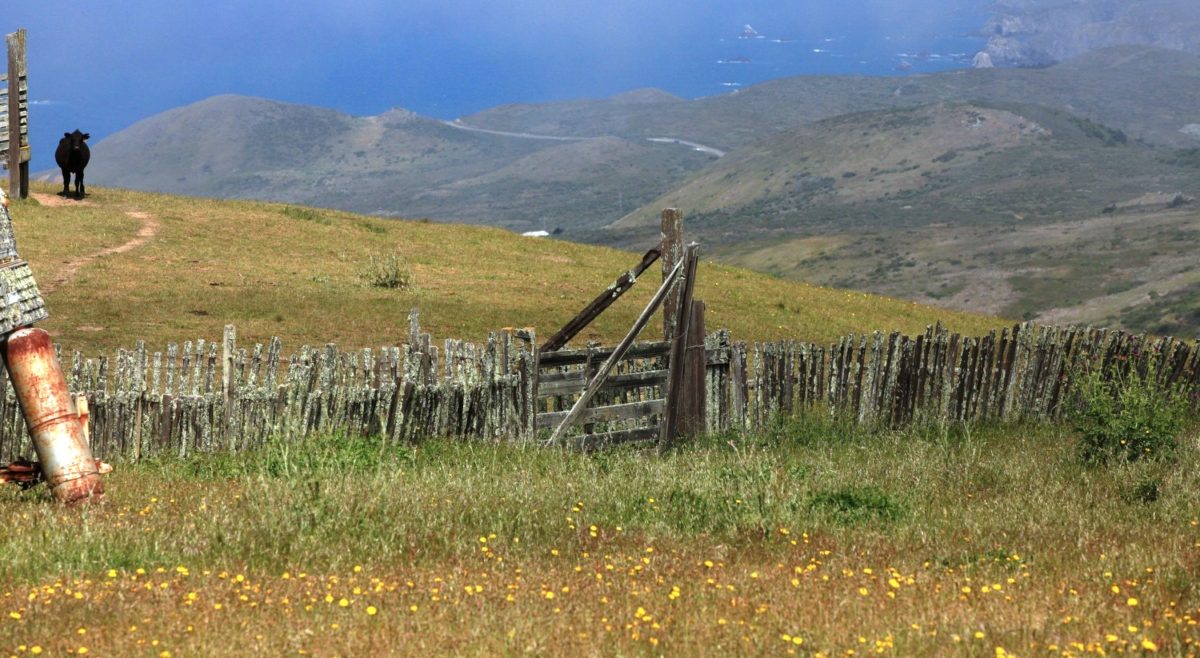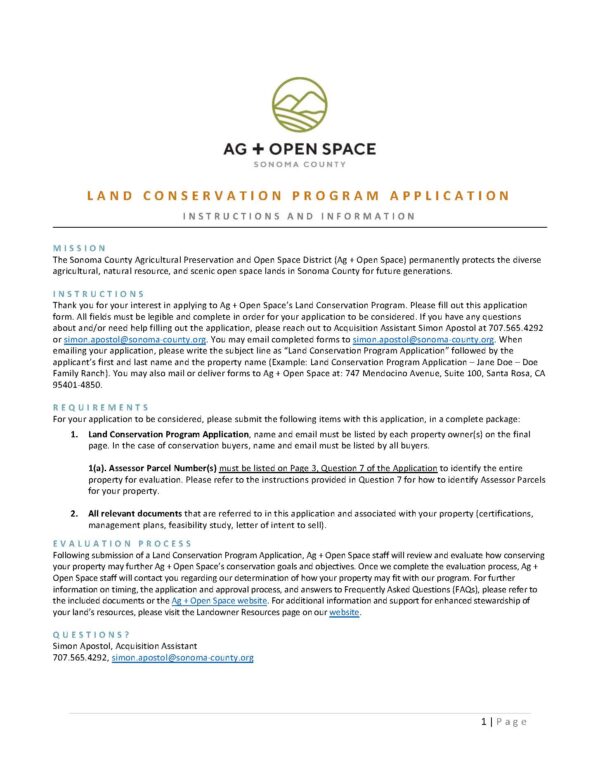Sonoma County Ag + Open Space uses a range of tools to protect private land. The most common is a “conservation easement,” which is a legal agreement between a landowner and a land trust or government agency that permanently limits uses of the land to protect its conservation values. However, we will buy land outright in some cases, or enter into perpetual agreements that require resource enhancement or particular management practices.
The process of working with Ag + Open Space to protect your land takes time. A typical conservation easement project takes between 1½ to 2 years, with four basic components: project evaluation, project structure, appraisal, approvals and escrow.
Frequently asked questions and helpful definitions:
Conservation Easement – How it worksConservation Easement – When to sell or donate
Conservation Easement – How it is valued
Property Sale
What is a conservation buyer and a conservation buyer transaction?
When will I hear back about my application?
How long does it take to establish a conservation easement?
My property is currently on the market and I want to pursue a sale with Ag + Open Space. How long would it take to close?
How are properties evaluated?
What is an agricultural covenant?
What are the potential tax benefits of selling a conservation easement?
Do I have to allow public access on my property if I sell a conservation easement?
Can I still use my property for personal recreation if I sell a conservation easement?
Conservation Easement – How it works
The most traditional tool for conserving private land is a “conservation easement,” which is a legal agreement between a landowner and a land trust or government agency that permanently limits uses of the land in order to protect its conservation values. It allows landowners to continue to own and use their land, and to sell or pass on the property to heirs. Subsequent owners are obligated to use the land under the terms of the conservation easement. The conservation easement is binding in perpetuity – in other words, forever.
Conservation easements are used to achieve a variety of conservation purposes, including agricultural preservation, open space and scenic resource preservation, and natural resource protection.
When you donate or sell a conservation easement to the District, you give up some of the rights associated with the land. For example, you might give up the right to build additional structures, while retaining the right to grow crops. Future owners also will be bound by the easement’s terms. The District’s stewardship staff monitors properties to ensure the terms of the conservation agreement are being met.
A conservation easement is a flexible tool, and is tailored for each specific property based on the common preservation goals of the landowner and the holder of the easement. An easement on property containing rare wildlife habitat or scenic landscapes might prohibit any development, for example, while an easement on a farm might allow continued farming and the addition of agricultural structures. An easement over forest land might restrict timber harvests to sustainable levels. A conservation easement does not require public access.
A conservation easement is an excellent tool for families who wish to keep their land intact to pass on to the next generation or to allow farmers to continue working their land, while generating needed income. Meanwhile, landowners retain title to the land and continue to occupy and use the lands under the terms of the conservation easement. This land remains in private ownership and is not open to the public.
In some cases the District will hold conservation easements over publicly-owned land, such as a park or open space preserve, which are open to the public. Please refer to our Protected Lands Map to see which properties are publicly accessible.
Back To Top
Conservation Easement – When to sell or donate
- If you need to sell your land but don’t want to see it subdivided or developed, you can work with the District prior to the sale to place a conservation easement on the land before it goes on the market.
- If you want to protect your land and could use additional income to retain your ownership or to enhance the property or agricultural operation, you can work with the District to place a conservation easement on your land at any time.
- If you want to buy land and prices are out of your reach, you can work with the District during the sale to place a conservation easement on the land at the time you purchase the property, thus reducing the cost to you. This is called a simultaneous transaction.
- If you want to buy additional land, you can work with the District during the sale to place a conservation easement on land you already own and then use the proceeds to purchase additional land. You can also simultaneously place a conservation easement on the land you are purchasing, which will reduce the cost of the purchase to you.
Back To Top
Conservation Easement – How it is valued
The District hires an independent third party appraiser to appraise the conservation easement and determine its fair market value. The appraiser does this by valuing the land before placement of the conservation easement and after placement of the conservation easement. The difference in those two values is the value of the conservation easement itself. The more restrictive the conservation easement is, the more market value it will have that the landowner can donate or sell to the District.
Back To Top
Property Sale
A landowner may sell property to the District if the property provides desired future recreational opportunities in addition to other open space benefits. We will then transfer the land to a state, regional, or local public entity or non-profit organization; or resell the property subject to a conservation easement. In some cases, the District may lease the property or a portion of the property to a farmer or rancher until such time that we transfer the property to another entity.
Back To Top
What is a conservation buyer and a conservation buyer transaction?
A conservation buyer is a real-estate purchaser who has interest in conserving the natural/agricultural/scenic/historic attributes of a property and subsequently works with a land trust to protect the values in perpetuity with a conservation easement. In a typical conservation buyer transaction, a land trust will protect a property by identifying (or being approached by) a buyer who is willing to purchase the land and subsequently sell or donate the conservation easement to the land trust. To move forward with the transaction, the seller would have to agree to sell the property to the conservation buyer.
Back To Top
When will I hear back about my application?
After a landowner submits their application, our Acquisition Assistant will contact them to confirm receipt of their application and whether their application is complete, or if we require more information. Applications are evaluated by a Property Evaluation Committee comprised of Ag + Open Space staff. A typical evaluation of an application and property takes 30 days, but depending on Committee members’ availability, could take more or less time. The Acquisition Assistant will be in regular communication with the landowner to discuss ongoing timelines throughout the entire process.
Back To Top
How long does it take to establish a conservation easement?
From the date a landowner’s application is accepted into our program, to the date a conservation easement is set into effect, the establishing of a conservation easement may take an average of a year or two and may require staff to schedule a site visit. Depending on staffing availability and financial resources, this process could take more or less time.
Back To Top
My property is currently on the market and I want to pursue a sale with Ag + Open Space. How long would it take to close?
Ag + Open Space does not typically want to hold ownership of land. Transactions that involve outright purchase generally require coordination with a third party such as a public agency, a non-profit, or a conservation buyer. Depending on a number of factors outright purchase can happen more quickly than a typical conservation easement or it may take longer. A conversation with the Ag + Open Space Acquisition Assistant prior to applying is advised.
Back To Top
How are properties evaluated?
Ag + Open Space prioritizes the conservation of lands that help further the goals and objectives outlined in our Vital Lands Initiative. Applications are evaluated by a Property Evaluation Committee, comprised of Ag + Open Space staff, who utilize the Vital Lands Initiative to see if a project is a good fit for our Land Conservation Program, Matching Grant Program, or Farmland for All. A typical evaluation of an application and property takes 30 days, but depending on Committee members’ availability, could take more or less time. The Acquisition Assistant will be in regular communication with the landowner to discuss ongoing timelines throughout the entire process.
Back To Top
What is an agricultural covenant?
In addition to a conservation easement, Ag + Open Space may want to ensure that an agricultural property remains in production permanently; if the landowner agrees, we would do this through a second agreement called an agricultural covenant. These covenants are legal documents and run with the land, as conservation easements do, meaning they remain in place permanently regardless of changes in land ownership. Agricultural covenants require willing landowners to keep agricultural lands in agriculture forever, in a manner that is also consistent with the terms of the conservation easement on the property.
Back To Top
What are the potential tax benefits of selling a conservation easement?
Ag + Open Space often purchases conservation easements at a discount; e.g., for less than their appraised value. The difference between the appraised value and the actual purchase price may qualify as a charitable contribution under IRS Regulations Section 170(h). Although Ag + Open Space may purchase a conservation easement for less than its appraised value, we cannot guarantee that a “bargain sale” will qualify as a charitable contribution with the IRS. Sale of a conservation easement may also reduce the assessed value of your property, which can lessen your liability for property taxes, depending on how long you have owned your property and other market factors. Consultation with a tax accountant or attorney for interpretation and specific advice on any personal tax matters is recommended. Ag + Open Space cannot provide financial advice to landowners.
Back To Top
Do I have to allow public access on my property if I sell a conservation easement?
Conservation easements themselves do not include requirements for public access, and landowners are not obligated to provide the public access to their property. However, if a landowner is interested in providing public access to their property – for example, through a public trail or outings – Ag + Open Space will work with the landowner to determine the best approach for establishing public access. This may be through a trail easement, trail offer to dedicate, and/or recreation covenant.
Back To Top
Can I still use my property for personal recreation if I sell a conservation easement?
Yes, however, some uses may be restricted or limited per the terms of the conservation easement. Part of the easement design process includes negotiations of uses in order to balance the landowner’s and Ag + Open Space’s goals for the property.
Back To Top

